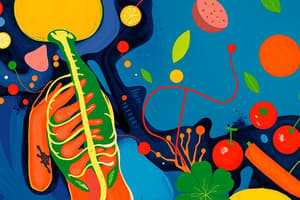Podcast
Questions and Answers
Match the following lipoproteins with their primary functions:
Match the following lipoproteins with their primary functions:
LDL = Deliver triglycerides from the liver to cells HDL = Pick up cholesterol for removal or recycling VLDL = Deliver cholesterol from the liver to cells Chylomicrons = Store triglycerides in adipose tissue
Match the following types of lipids with their characteristics:
Match the following types of lipids with their characteristics:
Triglycerides = Composed primarily of glycerol and fatty acids Cholesterol = A type of lipid that is not soluble in water Phospholipids = Form cellular membranes and contain phosphate groups Fatty acids = Basic building blocks of fats
Match the following statements with the appropriate lipoproteins:
Match the following statements with the appropriate lipoproteins:
LDL = Composed primarily of cholesterol HDL = Composed primarily of protein VLDL = Derived as triglycerides are broken down Chylomicrons = Transport dietary lipids from intestines
Match the following energy storage types with their calorie efficiency:
Match the following energy storage types with their calorie efficiency:
Match the following conditions with their implications:
Match the following conditions with their implications:
Flashcards are hidden until you start studying
Study Notes
Nutrition Overview
- Definition: Nutrition is the science of foods and their nutrients, examining their effects on bodily functions including ingestion, digestion, metabolism, and excretion.
- Foods: Derived from plants or animals, crucial for energy, growth, maintenance, reproduction, and lactation.
- Diet: Refers to the total food and beverage intake of an individual.
- Nutrients: Chemical substances from food required for energy, tissue structure, and functioning regulation.
Types of Nutrients
- Essential Nutrients: Must be acquired through food; the body cannot produce them sufficiently. Approximately 40 essential nutrients known.
- Nonessential Nutrients: Produced by the body in adequate amounts.
- Macronutrients: Required in large amounts (e.g., proteins, carbohydrates, lipids, water).
- Micronutrients: Needed in smaller amounts (e.g., vitamins, minerals).
Energy-yielding Nutrients
- Macronutrients provide calories:
- Carbohydrates: 4 kcal/g
- Proteins: 4 kcal/g
- Fats: 9 kcal/g
- Alcohol: Yields 7 kcal/g but is not classified as a nutrient.
Importance of Nutrition
- Essential for growth, development, and overall health.
- Contributes to illness prevention, enhancing quality and lifespan.
- Nutritional needs vary based on life stages, health status, cultural preferences, and genetic factors.
Nutritional Status & Assessment
- Measured using anthropometric indicators like height and weight, which can calculate Body Mass Index (BMI).
- WHO provides growth charts for children to assess physical development.
- Waist-to-hip ratio indicates body fat distribution and health risk.
Nutritional Assessment Methods
- Comprehensive nutrition assessment by trained professionals includes historical info, anthropometric data, physical examinations, and laboratory tests to identify deficiencies or imbalances.
Malnutrition
- Defined as insufficient, excessive, or imbalanced nutrient intake.
- Undernutrition: Insufficient energy or nutrients, leading to issues like weakness and growth faltering.
- Overnutrition: Excess intake can cause obesity, heart disease, and toxic vitamin levels.
Dietary Reference Intakes (DRIs)
- DRIs provide guidance for nutrient intake among healthy populations in the U.S. and Canada, including:
- Estimated Average Requirements (EAR)
- Recommended Dietary Allowances (RDA)
- Adequate Intakes (AI)
- Tolerable Upper Intake Levels (UL)
Energy Recommendations
- Estimated Energy Requirement (EER) helps maintain energy balance based on age, gender, weight, and activity level.
- Acceptable Macronutrient Distribution Ranges (AMDR):
- 45-65% kcal from carbohydrates
- 20-35% kcal from fats
- 10-35% kcal from proteins
Carbohydrates
- Composed of carbon, hydrogen, and oxygen; primary energy source for most organisms.
- Synthesized by plants via photosynthesis, with glucose as a key energy form.
- Types of carbohydrates classified based on sugar unit length:
- Monosaccharides: Simplest form (e.g., glucose).
- Disaccharides: Two monosaccharides bonded (e.g., sucrose).
- Oligosaccharides: Contain 3-9 sugar units, present in plant foods.
- Polysaccharides: Long chains of monosaccharides (e.g., starch, fiber).
Sources and Functions of Carbohydrates
- Major sources: Cereal grains, fruits, vegetables, dairy, and sugars.
- Functions include energy supply, sparing protein use, preventing ketosis, aiding in cell recognition, and providing dietary fiber for digestive health.
Dietary Fiber
- A type of carbohydrate that isn't fully absorbed; has important health benefits.
- Categories:
- Insoluble Fiber: Adds bulk to stool, promotes laxation (e.g., cellulose).
- Soluble Fiber: Slows digestion, reduces cholesterol, regulates blood sugar.
- Important for overall digestive health and reducing risks for chronic diseases like diabetes and cancer.
Conclusion
- Carbohydrates are a vital part of the diet and serve as the body’s primary energy source.
- Balancing carbohydrate intake is crucial for maintaining health and preventing diseases related to both undernutrition and overnutrition.### Carbohydrates Overview
- Carbohydrates are essential for energy, particularly for red blood cells, the brain, and the central nervous system.
- Sources of carbohydrates include bread, pasta, beans, potatoes, rice, and cereals, mainly consisting of starch.
- Carbohydrates are categorized into simple and complex types, impacting their digestion and energy supply.
Functions of Carbohydrates
- Broken down into glucose, serving as a primary energy source and spares proteins for other bodily functions.
- Excess intake is stored as glycogen in the liver and muscles, while surplus is converted into triglycerides for fat storage.
Digestion and Absorption
- Digestion aims to break carbohydrates down to glucose, primarily occurring in the gastrointestinal tract, with absorption through capillaries.
- Influencing factors for carbohydrate digestion include food form, fiber content, and carbohydrate type.
Utilization of Carbohydrates
- Utilization occurs via glycogen synthesis for energy, storage in muscle and liver, and conversion to fat when glycogen stores are full.
- Recommended daily intake is a minimum of 130 grams, comprising 45-65% of total calorie intake with fiber intake suggestions at 28 grams for a 2000-calorie diet.
Glucose Regulation
- Normal blood glucose levels are maintained between 4.5-10mmol/L, with insulin and glucagon hormones playing critical roles in management.
- Diabetics often struggle with carbohydrate metabolism, leading to elevated glucose levels.
Health Aspects of Carbohydrates
- Excess carbohydrates, particularly sugars, correlate with obesity and nutritional deficiencies when consumed in high amounts.
- Starch-rich foods provide dietary fiber, benefiting bowel health, and help prevent conditions like constipation and potentially colon cancer.
Fiber and Health Benefits
- High-fiber diets aid in weight management by increasing satiety and slowing digestion.
- Soluble fibers can lower blood cholesterol and regulate postmeal blood glucose levels, benefiting diabetic individuals.
Nutritional Guidelines and Recommendations
- Added sugars should not exceed 25% of total calories, with World Health Organization guidelines recommending no more than 10%.
- Dietary Reference Intakes (DRIs) establish nutrient needs based on individual health standards, with RDA providing sufficient nutrients for nearly all healthy individuals.
Protein Overview
- Proteins consist of amino acids, classified as essential (must be obtained from diet) and non-essential (synthesized by the body).
- Proteins play various roles, including tissue repair, energy source, and maintaining bodily functions like fluid balance and acid-base regulation.
Protein Types and Sources
- Includes complete proteins (animal sources), partially complete proteins, and incomplete proteins (plant sources).
- Important for growth, immune function, and nutrient transport within the body.
Digestion and Absorption of Protein
- Digestion starts in the stomach, where acids and enzymes break proteins down into amino acids, which are then absorbed in the small intestine.
- Absorbed amino acids serve multiple purposes, including energy production and synthesizing needed compounds.
Protein Deficiency and Health Implications
- Protein-energy malnutrition signifies inadequate protein and energy intake, leading to conditions like Kwashiorkor and Marasmus.
- High animal protein intake may increase heart disease risk, while plant proteins may lower such risks.
Recommended Intakes of Protein
- Protein should comprise 10-35% of total energy intake, with specific daily recommendations based on body weight.
- Protein powders are generally unnecessary for most individuals, with adequate protein sourced through a balanced diet.
Lipids Overview
- Lipids are energy-yielding compounds crucial for various bodily functions, including energy storage and insulation.
- The main types of lipids include triglycerides, phospholipids, and sterols, with fatty acids as key building blocks.
- Fatty acids vary in chain length and saturation, impacting their health effects and roles in the diet.### Fatty Acids
- Saturated fatty acids consist of carbon chains fully saturated with hydrogen through single bonds.
- Monounsaturated fatty acids have one double bond in the carbon chain.
- Polyunsaturated fatty acids contain multiple double bonds in the carbon chain.
Structure and Sources of Lipids
- Saturated fats primarily come from animal products like beef, poultry, cheese, and also from palm and coconut oils.
- Monounsaturated fats are found in olive oil, peanuts, and avocados.
- Polyunsaturated fats (PUFAs), such as linoleic acid (omega-6), are sourced from vegetable oils, fish, and margarine.
Characteristics of Solid Fats and Oils
- Firmness of fats at room temperature is influenced by their degree of unsaturation; polyunsaturated oils are typically liquid, while saturated animal fats are solid.
- Stability against oxidation is highest in saturated fats, making them less likely to spoil compared to polyunsaturated fats.
- Hydrogenation adds hydrogen to unsaturated fatty acids, increasing saturation and stability, but leads to the formation of trans-fatty acids, which can raise cholesterol levels.
Solid Fats vs Oils
- Solid fats, like butter and lard, are high in saturated and/or trans fats and come from animal sources; some plant-derived oils can also be high in saturated fats.
- Oils, which are liquid at room temperature, mainly consist of monounsaturated or polyunsaturated fats, including common types like corn, olive, and soybean oils.
Classes of Lipids
- Triglycerides make up 98% of dietary lipids; they consist of three fatty acids and one glycerol backbone.
- Phospholipids contain a water-soluble head and fat-soluble tail, essential for cell membranes, and function as emulsifiers.
- Sterols, such as cholesterol, are exclusively found in animal products and play significant roles in hormone production and cell membrane structure.
Cholesterol
- The body manufactures 800 to 1500 mg of endogenous cholesterol daily; dietary sources provide exogenous cholesterol.
- Excess cholesterol can lead to plaque formation in arteries, increasing heart attack and stroke risk.
- Soluble dietary fibers can help lower blood cholesterol levels.
Essential Fatty Acids
- Linoleic (omega-6) and linolenic (omega-3) acids must be consumed through diet for normal growth and disease prevention.
- Sources of omega-6 include seeds, vegetable oils, and meats; omega-3 can be found in flaxseeds, walnuts, and fatty fish like salmon.
Lipid Transport (Lipoproteins)
- Lipoproteins are clusters of lipids and proteins that transport lipids in the blood and lymph.
- Chylomicrons carry triglycerides from the intestine to cells.
- VLDL transports lipids from the liver to cells; LDL delivers cholesterol from the liver to tissues.
- HDL retrieves cholesterol from cells and transports it back to the liver for recycling.
Roles of Triglycerides
- Triglycerides provide 9 kcal per gram, making them an efficient energy storage form, surpassing carbohydrates and proteins.
- The body's fat storage ability is virtually unlimited, unlike limited glycogen storage in the liver; excess fat accumulation in non-adipose cells can be harmful, potentially leading to conditions like fatty liver and obesity.
Studying That Suits You
Use AI to generate personalized quizzes and flashcards to suit your learning preferences.





